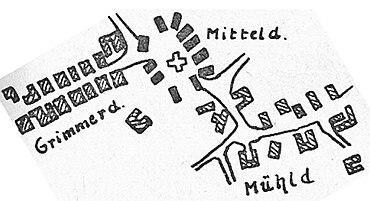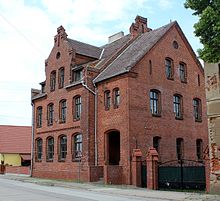Crawling
|
Crawling
City of Bad Liebenwerda
Coordinates: 51 ° 26 ′ 34 ″ N , 13 ° 22 ′ 0 ″ E
|
|
|---|---|
| Height : | 90 m |
| Residents : | 466 (December 31, 2008) |
| Incorporation : | December 6, 1993 |
| Postal code : | 04924 |
| Area code : | 035341 |
|
Location of Kröbeln in Bad Liebenwerda
|
|
Kröbeln is the southernmost district of the town of Bad Liebenwerda in the Elbe-Elster district in southern Brandenburg and is located about 9 kilometers south of the spa town not far from the border with Saxony on the edge of the Ziegram , a former 1000-hectare moor, swamp and peat area.
The place currently has 466 inhabitants.
Local division
Kröbeln originally consisted of three villages which belonged to different domains in the Middle Ages. The middle village was probably a settlement, to which Grimmerdorf (Krymerstorf) first joined after the German expansion to the east and Mühldorf in 1937 through a forced unification.
Forms of settlement
The middle village probably emerged from a larger, as yet unordered round shape, which is grouped around a central square on which the church was built after the eastward expansion. The western edge of the Rundweiler was formed by the Kleine Röder , on whose left bank German colonists built the street village of Grimmerdorf. To the south of the hamlet, the Mühldorf emerged later, with the character of a scattered settlement .
history
In the period between the Late Bronze Age and the Early Iron Age , a rampart was built near the town as a refuge or protective castle. This earth castle measured about 400 meters in an oval. The castle wall was used by tribes of the Teutons and Slavs in later times . On the outskirts of the current village there is also a burial ground with urns and urns.
1289 Kröbeln was mentioned for the first time in a document. Withego I. , bishop of Meissen , confirmed by Ulrich von Pack in Mühlberg / Elbe accomplished award of the tithe to "Croblin" to the Mühlberger monastery. In 1408 Grimmerdorf (Krymerstorf) was first mentioned. Konrad and Pope von Köckritz zu Saathain acted as owners.
In 1443 the rule of Mühlberg, which also included Kröbeln, fell from Electoral Saxony in an exchange transaction for the rule of Hohnstein to the Bohemian nobleman Hans Birke von der Duba .
In the 16th century the Liebenwerda office held court days alternately in Kröbeln and Kosilenzien . Together with the farmers from the villages of Hohenleipisch , Gorden , Bönitz , Kosilenzien and Zeischa , the people of Kröbelner were fined in 1514 because they held a large beer feast on Carnival without a permit. In 1520, after the death of Hinko Birke von der Duba, who died without an heir, Kröbeln fell to the Albertine Saxons with the rule of Mühlberg . In 1525 there were obvious effects of the peasant war in the place . The residents threw stones at the coffin of the deceased pastor and chose a new preacher on their own initiative. The authorities met the intention of not wanting to give any more interest or tithes to the church with "harsh exhortations". In 1529 19 Huefners and 1 gardener lived in the village. The pastor had a hoof of land available. In 1537 a fire was caused by lightning. The Liebenwerda official led the rescue work. In 1555 the plague broke out in Kröbeln.
As a result of the Thirty Years' War , only 13 Hüfner are left in the village in 1637. You only have 2 oxen and 3 cows. In 1647 a mill was mentioned in the village and in 1681 there was another outbreak of the plague.
After lawn iron stone was found in the area of Kröbeln in 1693 , a privilege to set up an ironworks was granted by the former Brandenburg iron factor Joh. Christoph Richter near Kröbeln, on Kröbelner and Saathainer Flur. On August 29, 1711, the iron hammer was sold to Christian Gabriel Meyer, district judge of Uebigau . He wanted to resume production in 1714. In 1725, lawn iron ore was delivered for the ironworks in Lauchhammer , a fact that speaks for the fact that the iron hammer of Kröbeln actually died.
In 1731 the community received 30 tree trunks from the Saxon elector Augustus the Strong to build the church . This was inaugurated on March 25, 1734. The organ builder Pfennig from Kröbeln-Mühldorf built the church organ in 1768. During the Napoleonic Wars , the peasants suffered from the constant passing troops. French soldiers demand fresh horses, oats and water from the farmers. In 1838 Kröbeln-Mühldorf was removed from the parish of Nieska and came to the parish of Kröbeln. The parish of Kröbeln also belonged to Kosilenzien.
On December 21, 1888, the new church bell weighing 308 kg was hung and consecrated. This was cast at the Ullrich company in Apolda . In 1892 an imperial post office was set up in town. On October 25 of the same year, separate meetings of community representatives took place in Grimmer- and Mitteldorf or Mühldorf to merge the places. However, an association is rejected. On May 17, 1909, the municipal council laid down conditions for the creation of another fish pond by the Saathain manor .
On March 28, 1914 a community representative meeting of both villages took place. The district administrator of Borke explained the project of a railway line from Burxdorf via Elsterwerda to Ortrand . Both villages wanted to buy shares here. After the municipal councils dealt with the project again in 1918/19, the planned stake should be increased (Grimmer- and Mitteldorf 35,000 Marks and Mühldorf 20,000 Marks), however, it failed and this route was never built. In 1921 the Röder Bridge was rebuilt by A. Muschter from Mühlberg / Elbe .
After a meeting of community representatives in Mühldorf in 1936 failed to merge with Grimmer- and Mitteldorf, on April 1, 1937, Kröbeln-Grimmer- and Mitteldorf and Kröbeln-Mühldorf became a forced unification .
On April 23, 1945, the Red Army met Kröbeln. During the land reform that took place in the same year, the fields of the Saathain manor were divided up . In Kröbeln three workers received 2.0369 hectares of land.
On December 6, 1993 the community lost its political independence and was incorporated into the city of Bad Liebenwerda .
More historical data
- In 1835 Cröbeln-Grimmerdorf owned 42 houses with 277 inhabitants, 41 horses, 207 head of cattle and 30 pigs.
- In 1835 Cröbeln-Mühldorf owned 25 houses with 116 inhabitants, 21 horses, 118 head of cattle, 202 sheep, 5 goats and 21 pigs.
- 34 residents of both districts fell victim to the First World War .
- 67 residents were killed in the Second World War .
- 1953 Foundation of LPG Type III "Liberation Day"
- 1965 Inauguration of the athletes' home and sports field
- 1976 Construction of the new kindergarten with 40 places
religion
The Lutheran parish Kröbeln belongs to the Mühlberg parish in the Bad Liebenwerda parish of the Evangelical Church in Central Germany . On the Catholic side, Kröbeln is assigned to the parish of St. Franziskus , whose parish church is the Herz-Jesu-Kirche in Bad Liebenwerda ; the community belongs to the deanery Torgau in the diocese of Magdeburg .
Attractions
The castle wall, which was built by Slavic tribes around 3000–4000 years ago, is one of the ground monuments in the Elbe-Elster district today . Located directly on the newly built cycle path, it invites you to linger, relax and also to discover. Many rare animal and plant species are at home here.
literature
- Wolfgang Eckelmann, Michael Ziehlke: Chronicle of the city of Liebenwerda. Edited by Association for City Marketing and Economy Bad Liebenwerda eV Winklerdruck GmbH Gräfenhainichen, Bad Liebenwerda 2007, p. 252 to 253 .
Individual evidence
- ↑ Population development of the Bad Liebenwerda districts on the city's homepage ( online as a PDF file ( Memento from November 30, 2012 in the Internet Archive ))
- ↑ Home calendar for the Bad Liebenwerda district, 1959, p. 79
- ↑ Karl Fitzkow "On the older history of the city of Liebenwerda and its district area - Heft 2" 1961
- ^ Changes in the municipalities of Germany, see 1993 StBA
- ↑ a b "Overview of the population and the cattle stock in 1835" in "The Black Elster - Our home in words and pictures" . No. 596 . Bad Liebenwerda 1985, p. 8 to 10 .




